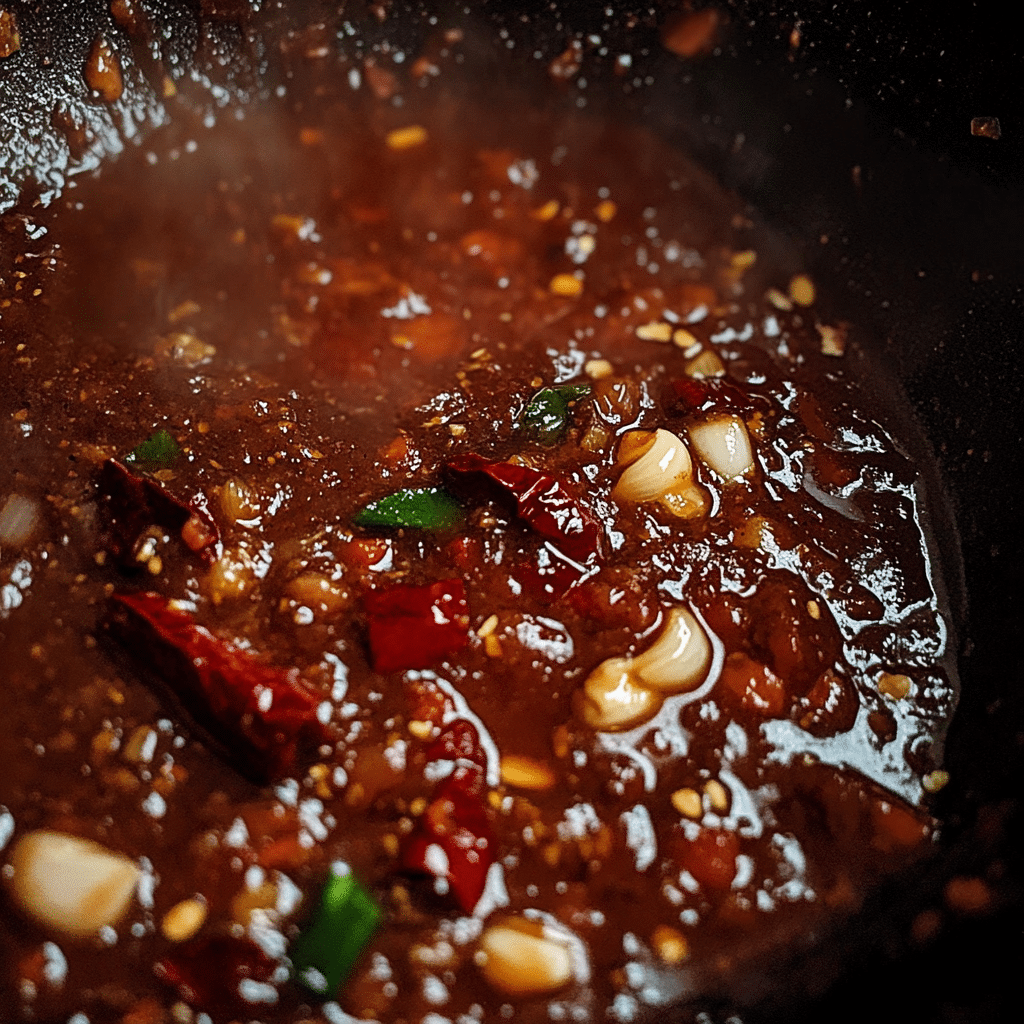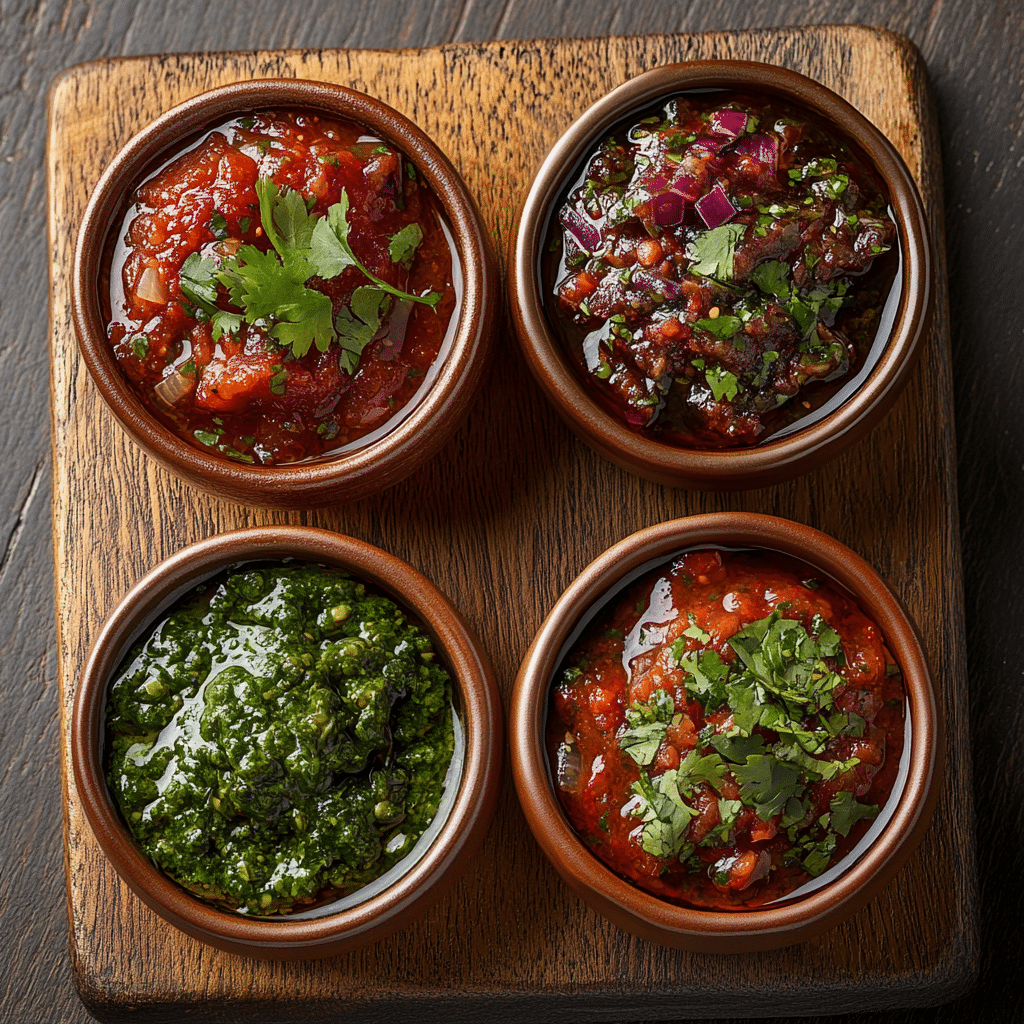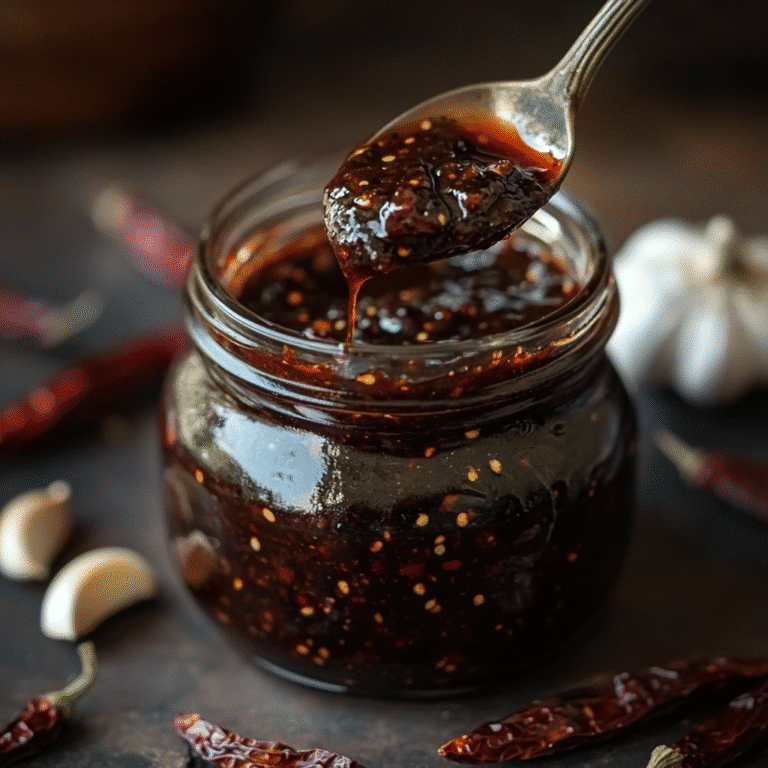Salsa Negra is more than just a condiment—it’s a smoky, flavor-packed creation born from the heart of Mexican cuisine. As someone who loves crafting comforting, Mediterranean-inspired recipes with bold character, I’m always looking for new ways to bring authentic flavors to everyday meals. This dark, rich sauce does exactly that, adding a subtle kick and deep umami to everything from roasted vegetables to grilled meats.
In this article, I’ll walk you through the history and ingredients behind this treasured sauce. You’ll discover how to make it from scratch, ways to use it creatively, and what makes it so different from other salsas. Whether you’re just curious about traditional Mexican condiments or ready to whip up your first batch, this guide is packed with everything you need.
Don’t miss our Tacos Rojos Potosinos, where Salsa Negra can take center stage for a flavor upgrade.
Table of Contents

Salsa Negra – The Bold, Smoky Flavor Your Pantry Needs
- Total Time: 20 minutes
- Yield: 1 cup
Description
Salsa Negra is a bold, smoky Mexican sauce made with dried chilies, garlic, soy sauce, and brown sugar. Perfect for drizzling over tacos, meats, vegetables, or adding to marinades.
Ingredients
- 5 dried chipotle or pasilla chiles, stemmed and seeded
- 4 garlic cloves, peeled
- 3 tablespoons soy sauce
- 2 tablespoons brown sugar
- ½ cup vegetable or canola oil
- 1 tablespoon vinegar or lime juice
- Salt to taste
Instructions
- Toast the chiles in a dry skillet for 1–2 minutes until fragrant.
- Heat oil in a pan over medium heat. Add garlic and chiles. Cook for 4–5 minutes until darkened but not burnt.
- Transfer to a blender. Add soy sauce, brown sugar, vinegar, and salt. Blend until smooth.
- Return to the pan and simmer on low heat for 5–7 minutes to thicken and enhance flavor.
- Let cool, then store in a glass jar in the refrigerator for up to 3 weeks.
Notes
For a spicier version, add a few arbol or morita chiles. To reduce heat, substitute with ancho chiles. Store with a thin layer of oil on top to preserve freshness.
- Prep Time: 10 minutes
- Cook Time: 10 minutes
- Category: Condiment
- Method: Stovetop
- Cuisine: Mexican
The Origins of Salsa Negra
Historical Background of Salsa Negra
Salsa Negra, known as “black salsa” in English, has deep roots in traditional Mexican cooking, particularly in regions like Veracruz and Puebla. This rich, dark, smoky sauce evolved from indigenous culinary practices that prized smoked chili peppers, fermented condiments, and slow-roasting methods. Over generations, the recipe has been influenced by Spanish colonization, Caribbean spice routes, and even Middle Eastern trade, which introduced vinegar and certain aromatics still found in Salsa Negra today.
Originally, Salsa Negra was crafted to preserve chilies and add intensity to bland staple dishes like tortillas and beans. As households began experimenting, the sauce became a staple in rural and urban kitchens alike—transitioning from humble origins to a gourmet condiment in modern cuisine.
This evolution reflects Mexico’s ability to fuse tradition with innovation. Even now, families pass down their own secret variations of Salsa Negra, each one slightly unique but always deeply flavorful.
Cultural Significance in Mexican Cuisine
Salsa Negra is more than just a condiment—it’s an emblem of bold Mexican flavor and regional pride. In culinary circles, it is admired for its ability to elevate street food as well as high-end gastronomy. From street tacos to contemporary fusion menus, this salsa adds complexity with just a drizzle.
In Veracruz, where seafood meets spice, Salsa Negra often appears alongside fried fish or shrimp. In Oaxaca, it may be used in tamales or even mole recipes. Its rich, umami-loaded profile often stands in for meat in vegetarian dishes, giving depth without overpowering the main ingredients.
Salsa Negra also appears in festivals and family celebrations, especially during Día de los Muertos and Christmas, where it’s served with tamales or roasted meats. The sauce embodies hospitality, heritage, and heat—three things at the core of Mexican culinary identity.
Discover great ideas like Mexican Tortilla Cinnamon Rolls for a unique sweet-savory combo inspired by Mexican fusion.
What Is Salsa Negra Made Of?
Core Ingredients in Traditional Salsa Negra
At its heart, Salsa Negra is a simple, deeply flavorful sauce made from a handful of pantry staples. The key to its distinctive taste lies in the combination of dried chilies, oil, garlic, soy sauce, and brown sugar—ingredients that, when blended and simmered, create a rich, dark, smoky paste.
Let’s break down the traditional base:
| Ingredient | Function |
|---|---|
| Dried chipotle or pasilla chiles | Adds smokiness, heat, and depth |
| Garlic | Delivers pungency and aromatic sharpness |
| Oil (typically vegetable or canola) | Used for sautéing and carrying flavors |
| Brown sugar | Provides sweetness and counteracts bitterness |
| Soy sauce | Adds saltiness and umami richness |
| Vinegar or lime juice | Adds acidity for balance and preservation |
This version of Salsa Negra is a chili-oil-style salsa with caramelized notes and a sticky texture. The slow cooking method is crucial. It intensifies the flavors while mellowing out the bitterness that dried chiles can carry.
Depending on the household or region, some variations may include:
- Toasted sesame seeds for nuttiness
- Worcestershire sauce for an umami kick
- Tamarind for tanginess
- Roasted tomatoes or onions for extra body
The beauty of Salsa Negra lies in its flexibility—it welcomes bold twists while staying true to its smoky soul.
Regional Variations and Modern Twists
Although rooted in traditional Mexican kitchens, Salsa Negra continues to evolve. In Baja California, chefs often swap soy sauce for fish sauce or Maggi seasoning, creating a bolder, saltier take that pairs well with seafood tacos. In the Yucatán Peninsula, cooks infuse it with achiote or habanero to match the region’s fiery heat preferences.
Today, Salsa Negra is also being modernized in home kitchens and by chefs who merge global ingredients. Think: truffle oil infusions, Korean gochujang crossovers, or vegan versions using coconut aminos instead of soy.
These innovations make it easy to adapt the sauce to specific diets—gluten-free, vegan, low-sodium—without losing the essence of what makes Salsa Negra unforgettable.
Looking for inspiration? Try Banana Coffee Syrup for a sweet twist in your condiment collection.
Flavor Profile & Spice Level of Salsa Negra
Is Salsa Negra Spicy? Understanding Its Heat Levels
Salsa Negra is known for its smoky, savory character with a mellow heat that sneaks up rather than slams your taste buds. It’s typically less fiery than habanero salsas, but spicier than your average tomato-based sauce. The heat level varies depending on the type of dried chili used—chipotle and pasilla peppers are common choices, each offering a mild to medium kick with a smoky and sweet backbone.
What makes Salsa Negra so intriguing is its layered flavor. You first taste a bit of sweetness from brown sugar, followed by a bold, earthy smokiness, and then a slow-burning heat that lingers gently. It’s the perfect example of spice with complexity, not just heat for the sake of it.
For those sensitive to spice, adjusting the heat is easy. Simply reduce the number of chilies or swap in ancho peppers, which are milder. On the flip side, chili lovers can crank up the fire with arbol chiles or morita peppers.
Comparing Salsa Negra to Other Spicy Sauces
While Salsa Negra delivers heat, it’s in a completely different league than sauces like Sriracha or habanero salsa. Think of it as a chili oil meets barbecue sauce hybrid with a Mexican twist. It’s more about enhancing the flavor of food than overwhelming it.
Here’s a quick breakdown comparing popular Mexican and global sauces:
| Sauce | Heat Level | Flavor Notes | Texture |
|---|---|---|---|
| Salsa Negra | Mild to Medium | Smoky, sweet, umami | Thick and oily |
| Salsa Roja | Medium | Tomato-based, tangy | Smooth and thin |
| Salsa Verde | Mild to Hot | Fresh, tart, herbal | Chunky or smooth |
| Habanero Salsa | Hot | Fiery, citrusy | Thin |
| Sriracha | Medium | Sweet, garlicky, tangy | Thick |
Salsa Negra’s ability to balance sweetness, smokiness, and subtle heat makes it incredibly versatile. You can use it as a marinade, dipping sauce, or finishing drizzle—without worrying about it stealing the show or burning your tongue.
Discover great ideas like Tortilla Cinnamon Rolls that can be surprisingly delicious with a dash of smoky spice.
How to Make Authentic Salsa Negra at Home
Step-by-Step Homemade Salsa Negra Recipe
Making Salsa Negra at home is easier than it looks. With just a few ingredients and a bit of patience, you can create a restaurant-quality black sauce packed with flavor. This recipe brings out the best of what Salsa Negra has to offer: smoky heat, deep umami, and a subtle touch of sweetness.

Ingredients (Yields ~1 cup):
- 5 dried chipotle peppers (or pasilla for milder flavor)
- 4 cloves of garlic, peeled
- 3 tablespoons soy sauce
- 2 tablespoons brown sugar
- ½ cup neutral oil (vegetable or canola)
- 1 tablespoon vinegar or lime juice
- Salt to taste
Instructions:
- Prepare the chiles: Remove stems and seeds. Toast them lightly in a dry skillet until fragrant—about 1–2 minutes per side.
- Fry garlic and chiles: Heat oil in a pan over medium heat. Add garlic and chiles. Cook gently until both are darkened but not burnt—about 4–5 minutes.
- Blend the mixture: Transfer to a blender. Add soy sauce, brown sugar, vinegar, and a pinch of salt. Blend until smooth.
- Simmer the sauce: Return the mixture to the pan. Simmer over low heat for 5–7 minutes to thicken and intensify the flavors.
- Cool and store: Let it cool, then pour into a glass jar. Store in the refrigerator for up to 3 weeks.
This version of Salsa Negra stays true to its roots while using accessible ingredients. It’s perfect for drizzling on tacos, brushing on grilled meats, or adding to beans and rice.
Tips for Storing and Preserving Your Sauce
Once you’ve made a batch of Salsa Negra, storage is key to maintaining its rich flavor and smooth texture. Here are some quick tips:
- Use sterilized jars to extend shelf life.
- Store in the refrigerator and use a clean spoon each time to prevent contamination.
- Add a thin layer of oil on top to preserve freshness.
- Freeze in small silicone cubes for quick single-use portions.
Pro tip: The flavor of Salsa Negra actually improves over time. After 2–3 days in the fridge, the heat mellows and the flavors meld beautifully.
Don’t miss our Mexican Tortilla Cinnamon Rolls to add a savory twist using this versatile sauce.
Salsa Negra vs. Other Mexican Salsas
How Salsa Negra Compares to Salsa Roja, Verde, and Macha
In the diverse world of Mexican salsas, each type has its own signature personality. Salsa Negra stands out not just for its color, but for its deep umami flavor and oily texture. While Salsa Roja and Salsa Verde are often made fresh with tomatoes or tomatillos, Salsa Negra is cooked and preserved, lending it a longer shelf life and bolder flavor.

Here’s how it stacks up:
| Salsa Type | Main Ingredients | Flavor Profile | Best For |
|---|---|---|---|
| Salsa Negra | Dried chiles, soy, sugar | Smoky, sweet, umami | Marinades, tacos, grilled meat |
| Salsa Roja | Tomato, onion, jalapeño | Bright, tangy, mildly spicy | Tacos, eggs, rice |
| Salsa Verde | Tomatillo, lime, cilantro | Tart, herbal, zesty | Enchiladas, chips |
| Salsa Macha | Dried chiles, nuts, oil | Crunchy, nutty, spicy | Toppings, roasted vegetables |
Salsa Negra’s unique richness often earns it comparisons to BBQ sauce or Asian chili oil. It’s thicker, darker, and more intense than its cousins, making it an ideal choice for when you want to dial up the flavor without overwhelming the dish.
Which Salsa to Use When? Flavor vs. Heat vs. Texture
Choosing the right salsa depends on the texture, taste, and temperature of the food you’re pairing it with.
- Want to boost flavor on grilled chicken or steak? Go for Salsa Negra—it clings beautifully to meats and adds layers of complexity.
- Need a bright, acidic topping for fish tacos? Salsa Verde is your friend.
- Looking for a traditional taco shop salsa? Salsa Roja delivers balanced spice and freshness.
- Craving heat and crunch? Salsa Macha is bold and textured with bits of roasted nuts and seeds.
Salsa Negra is versatile, but it shines when you want to add depth rather than brightness. It’s not a salsa to drown chips in—it’s one to drizzle, layer, and savor.
Check out Tortilla Cinnamon Rolls for an unexpected dish that pairs surprisingly well with smoky sauces like this one.
Creative Ways to Use Salsa Negra
Pairing Ideas: Tacos, Grilled Meats, Eggs & More
One of the best things about Salsa Negra is its versatility—it’s not just a taco topping. This rich, smoky black sauce can elevate everyday meals into gourmet experiences. Its balance of sweet, spicy, and umami makes it an all-purpose flavor booster.

Here are some go-to pairing ideas:
- Street-style tacos: Drizzle over carne asada, carnitas, or even grilled mushrooms for a bold finish.
- Breakfast eggs: A spoonful over scrambled eggs or a fried egg sandwich adds depth and heat.
- Grilled meats: Use as a finishing glaze or a side sauce for steak, chicken thighs, or pork ribs.
- Sandwiches & wraps: Spread on a torta or veggie wrap for added smoky richness.
- Soups & stews: Stir into black bean soup or chili for complexity.
- Roasted veggies: Toss roasted cauliflower or Brussels sprouts in a little Salsa Negra for a spicy twist.
Salsa Negra’s flavor profile is strong enough to stand up to bold ingredients but refined enough to work in delicate combinations.
Fusion Dishes and Mediterranean Mashups
Since your cooking style is Mediterranean-inspired, it’s worth noting that Salsa Negra blends beautifully with many dishes from that region. Think beyond tacos and try these ideas:
- Grilled eggplant with Salsa Negra drizzle
- Roasted lamb with black chili glaze
- Charred halloumi or feta served with black salsa and olives
- Flatbreads with hummus and a swirl of smoky chili oil
- Pasta tossed with Salsa Negra and garlic-infused olive oil
These mashups allow you to experiment while staying true to bold, homemade cooking. Salsa Negra’s ability to cross culinary boundaries makes it a perfect fit for modern, global kitchens.
What Is Picante Negra?
Difference Between Salsa Negra and Picante Negra
It’s easy to confuse Salsa Negra and Picante Negra, especially since both are dark, chili-based sauces with Mexican roots. However, they serve different culinary roles and have distinct flavor profiles.
Salsa Negra is typically thick, slightly sweet, and smoky. It’s made with dried chilies (like chipotle or pasilla), garlic, soy sauce, and sugar. The result is a sauce with a deep umami taste and a smooth, oily finish. It’s more about richness and complexity than fiery heat.
Picante Negra, on the other hand, puts the “picante” (spicy) front and center. It tends to be thinner, spicier, and more vinegar-forward. While it shares some ingredients with Salsa Negra, it usually leans harder on vinegar, hot chili oil, or habaneros, and skips the sweetness.
| Feature | Salsa Negra | Picante Negra |
|---|---|---|
| Texture | Thick and oily | Thinner and more fluid |
| Heat Level | Mild to medium | Medium to high |
| Sweetness | Slightly sweet | Typically none |
| Main Use | Marinades, glazes, dipping sauces | Hot sauce replacement, spicy dishes |
| Flavor Profile | Smoky, umami, subtle heat | Tangy, sharp, direct spice |
When to Use Picante Negra Instead
While Salsa Negra shines when you want to add depth and complexity, Picante Negra is better suited when you’re after quick, sharp heat. It’s the kind of sauce you splash on:
- Tacos al pastor for an acidic kick
- Grilled shrimp where citrus and spice pair perfectly
- Ceviche or seafood cocktails needing that peppery zip
- Steamed vegetables for contrast and brightness
If your dish already has sweetness or richness, and you want to balance it with fire, Picante Negra is the better choice. But when you want a more mellow, flavor-forward heat, Salsa Negra remains unmatched.
Exploring Tierra Negra Salsa Ingredients
What Makes Tierra Negra Unique?
Tierra Negra Salsa is a premium take on Salsa Negra, known for its gourmet quality and small-batch craftsmanship. It has quickly gained popularity among foodies and chefs alike for its intense depth, artisanal blend, and unique heat profile. While it still falls under the broader category of black salsas, its flavor leans toward the earthy and fermented side, with added touches that set it apart.
What distinguishes Tierra Negra from traditional Salsa Negra is its refined ingredient sourcing and fermentation process, giving it a more complex, aged taste. This salsa is less sweet, slightly more acidic, and incredibly layered—ideal for those who appreciate bold but balanced flavors.
Its consistency is also slightly thinner than the classic homemade version, making it more pourable and versatile for restaurant plating or upscale dishes.
Ingredient Breakdown and Taste Analysis
Tierra Negra’s recipe may vary slightly by brand, but here’s a common ingredient profile found in artisanal versions:
- Dried Morita or Chipotle Chiles – Provide smoky, fruity heat
- Black Garlic or Roasted Garlic – For umami depth and sweetness
- Apple Cider Vinegar – A tangy, fermented note
- Organic Brown Sugar – Mild sweetness (in smaller quantities than standard recipes)
- Soy Sauce or Tamari – Adds umami and salt
- Sesame Oil – Nutty, toasted aroma and mouthfeel
- Sea Salt – Rounds out flavors
This mix creates a salsa that is smoky, tangy, rich, and slightly peppery with a smooth finish. It’s excellent on grilled vegetables, roasted meats, or even artisan cheese boards.
Pro tip: Because of its complexity, Tierra Negra Salsa pairs beautifully with earthy vegetables like mushrooms or beets, and it can even replace Worcestershire sauce in modern recipes.
Health Benefits & Nutritional Value of Salsa Negra
Is Salsa Negra Healthy? Key Nutrients Explained
When enjoyed in moderation, Salsa Negra can be part of a healthy, balanced diet. While it’s not a low-calorie food, it offers several nutritional perks, especially when homemade with whole ingredients.
Here’s a breakdown of key benefits:
- Capsaicin from chilies: Boosts metabolism, supports pain relief, and may improve heart health.
- Garlic: Rich in antioxidants and anti-inflammatory compounds that support immunity.
- Vinegar: Helps balance blood sugar levels and supports gut health.
- Soy Sauce: Provides umami but should be consumed in moderation due to sodium content.
- Oil: Acts as a healthy fat carrier if using canola or avocado oil.
| Nutrient | Per 1 Tbsp (Homemade) |
|---|---|
| Calories | ~40–60 |
| Fat | ~5g |
| Sodium | ~150–200mg |
| Sugars | ~1–2g |
| Fiber | ~0.5g |
While store-bought versions of Salsa Negra may contain preservatives, thickeners, and added sugar, homemade recipes can be tailored to dietary needs, including vegan, gluten-free, and low-sodium diets.
Calorie Count and Dietary Tips for Moderation
Salsa Negra isn’t meant to be consumed in large amounts—it’s a condiment, not a main course. One tablespoon adds a big burst of flavor for a relatively small calorie cost.
To keep it light:
- Use it as a finishing drizzle rather than a marinade base.
- Choose low-sodium soy sauce or tamari for a healthier option.
- Reduce added sugar or replace it with natural alternatives like date paste or molasses.
For those on a low-carb or keto diet, Salsa Negra can be a flavorful, compliant option when made without sugar. Its rich taste can make simple meals like grilled chicken or steamed vegetables more satisfying without added carbs.
In short, Salsa Negra is flavorful and functional—when prepared thoughtfully, it supports both taste and wellness.
Conclusion
Salsa Negra isn’t just another sauce—it’s a flavor experience that brings together smoke, spice, and sweet umami in perfect balance. Whether you’re drizzling it on tacos, blending it into marinades, or using it to elevate Mediterranean favorites, this bold black salsa deserves a permanent spot in your kitchen.
We’ve explored everything from the origins of Salsa Negra and its authentic ingredients, to how it compares with other Mexican salsas and how you can craft your own batch at home. We even dug into Picante Negra, modern brands like Tierra Negra, and the nutritional facts that make this sauce both delicious and functional.
For home cooks looking to add a touch of depth and authenticity to their meals, Salsa Negra is a game-changer. It’s versatile, easy to make, and absolutely bursting with flavor.
Frequently Asked Questions About Salsa Negra
What is Salsa Negra made of?
Salsa Negra is made primarily from dried chili peppers (commonly chipotle or pasilla), garlic, soy sauce, brown sugar, and oil. The ingredients are cooked and blended to create a dark, thick, and smoky sauce with a hint of sweetness and deep umami. Some variations also include vinegar, sesame seeds, or tamarind for added complexity.
What spice level is Salsa Negra?
Salsa Negra typically ranges from mild to medium heat, depending on the type of chilies used. Chipotle chilies give it a smoky, subtle heat, while adding arbol or morita peppers can raise the intensity. Unlike salsas that are designed to be fiery, Salsa Negra focuses more on flavor depth than pure spiciness.
What is Picante Negra?
Picante Negra is a spicier, more acidic cousin of Salsa Negra. While both are dark and chili-based, Picante Negra skips the sweetness and leans heavily into vinegar and chili oil, making it sharper and hotter. It’s often used like a hot sauce—great for tacos, ceviche, or anything that needs a bold kick of heat.
What are the ingredients in Tierra Negra salsa?
Tierra Negra salsa is a gourmet version of Salsa Negra, typically crafted with dried Morita chilies, black garlic, apple cider vinegar, soy sauce, and a touch of organic sugar or molasses. Some versions include sesame oil or fermented spices to elevate its flavor profile. It’s known for being rich, smooth, and layered—perfect for upscale pairings.
Follow us on Facebook for fresh new recipes, cooking tips, and food inspiration every week!

